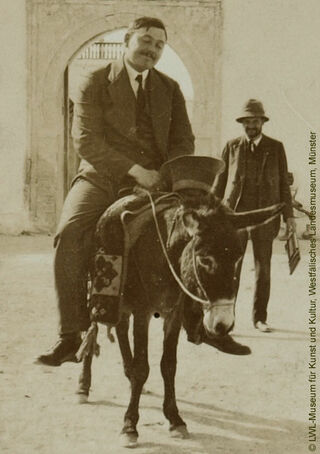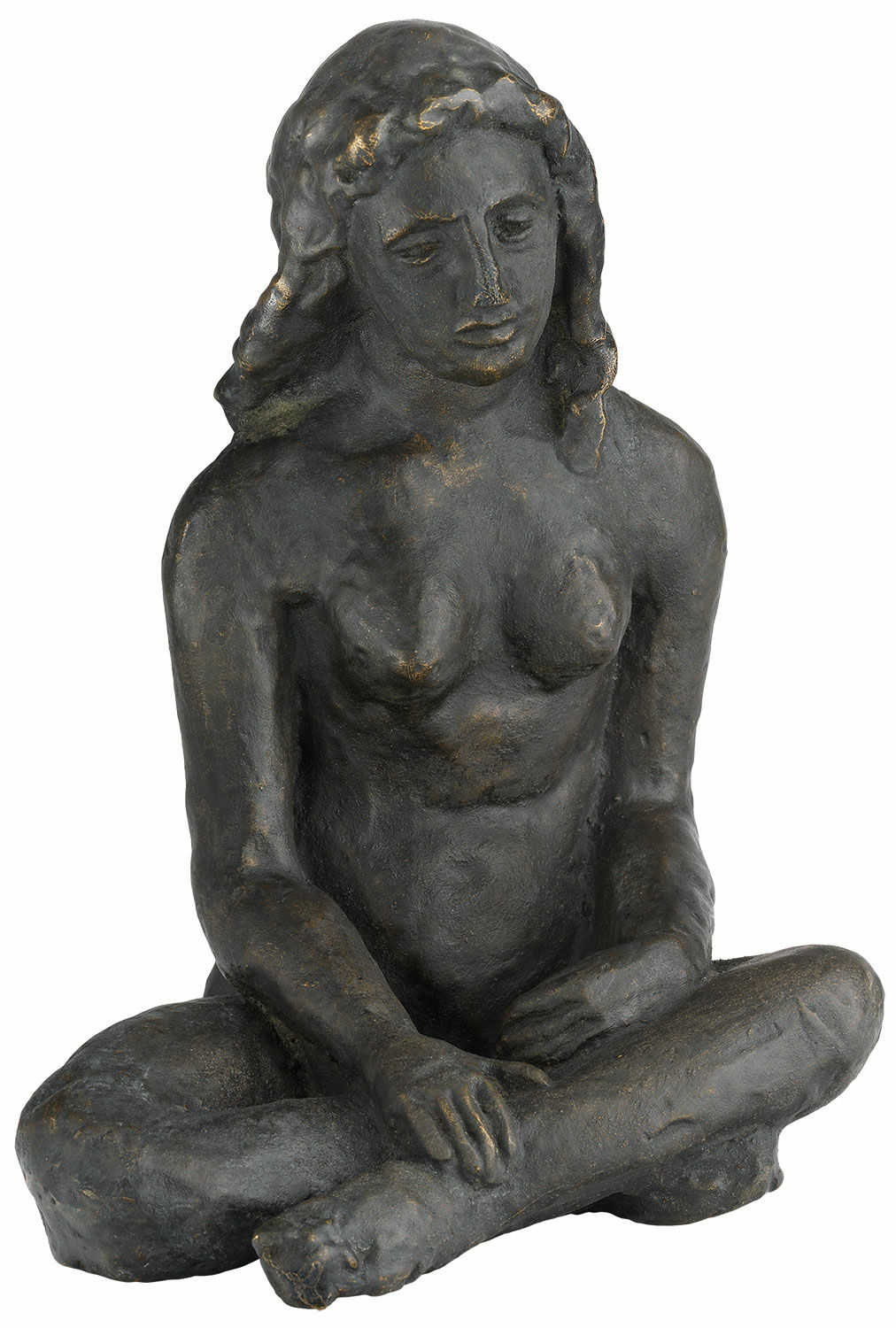Sculpture "Seated Woman" (1912), bronze
Sculpture "Seated Woman" (1912), bronze
Quick info
ars mundi Exclusive Edition | limited, 100 copies | numbered | hallmarked | certificate | bronze | chased | polished | patinated | size 23 x 16 x 14 cm (h/w/d) | weight approx. 4.8 kg
Video
Detailed description
Sculpture "Seated Woman" (1912), bronze
"The bronze sculpture of the 'Seated Woman' testifies to the great interest in different art techniques and the accompanying joy in experimenting with materials of the artist August Macke, who is known today in particular as a painter and draughtsman. The closed posture and the gaze directed into the indefinite convey inner contentment and tranquillity emanating from the sitter, which is also expressed in Macke's drawings and paintings. This basic mood fully corresponds to the artist's idea of a peaceful existence." (Dr Arnhold, Museum Director, LWL Museum of Art and Culture, Münster)
Original: 1912, plasticine, 23 x 17 x 15.5 cm, inv. no. F-1029 LM, donated by the Macke heirs.
Sculpture in fine bronze, cast using the Lost-Wax-Process, chiselled by hand, polished and patinated. Limited edition of 100 copies, numbered and hallmarked with the foundry and ars mundi stamp. With numbered certificate of authenticity and limitation. Size 23 x 16 x 14 cm (h/w/d). Weight approx. 4,8 kg. Published in cooperation with the LWL Museum of Art and Culture, Münster. ars mundi Exclusive Edition.

About August Macke
1887-1914
Radiant yellow, bright red, strong blue: the intensity and unique luminosity of the colours are typical of August Macke's work. In his paintings, Macke shows an intact world and primarily focuses on people. Probably because of the influence of his origins and the Rhenish cheerfulness, both as a person and as a painter, August Macke is considered to be one of the most famous German painters of the 20th-century.
Macke was a member of the artists' association "Blauer Reiter" and the most important representative of Rhenish Expressionism. He is considered the greatest German colour talent of his generation. But his drawings, sketches and designs also prove that he is one of the great artists of the 20th-century.
August Macke, born in Meschede on 3 January 1887, began his studies at the Kunstgewerbeschule and Kunstakademie Düsseldorf but dropped out prematurely. On journeys to France, Italy and the Netherlands he studied mainly Impressionism. With the artists of the "Blaue Reiter", whom he had known since 1911, he exhibited several times and contributed to the eponymous almanack. His financial security was assured by his sponsor Bernhard Koehler, an uncle of his wife Elisabeth.
Macke had already found his style of unmistakable independence. Inspired by Cézanne's tectonic pictorial structure and Matisse's flatness, he combined analytical Cubism with the pure colourfulness of Fauvism. The prismatic colours were the principal elements with which August Macke composed his painting. In doing so, the artist used the colours like a musician uses the tones, chords and scales of colourful forms.
As early as 1910, his friendship with Franz Marc enabled him to spend time at Lake Tegernsee. Macke's sensitivity for light effects was already evident in the paintings he created there. This is heightened in the watercolour paintings he produced on the famous trip to Tunis he made with Paul Klee and Louis Moillet in 1914. Simplification of form and the luminosity of the colours characterise this series of works.
For the first time in 1913, Macke‘s work was exhibited together with the works of the European avant-garde at the Sonderbund exhibition in Cologne, which he co-organised.
From 1913 Macke lived in Switzerland with his wife Elisabeth and his son Walter. But the family's happiness only lasted for a short time. As soon as the First Wolrd War began, August Macke was killed on the battlefield in Champagne, France, on 26 September 1914. His friend Franz Marc commented: "The greedy war is a hero's death richer, but German art poorer by one hero."
An alloy of copper with other metals (especially with tin) used since ancient times.
When casting bronze, the artist usually applies the lost-wax technique which is dating back more than 5000 years. It's the best, but also the most complex method of producing sculptures.
First, the artist forms a model of his sculpture. It is embedded in a liquid silicone rubber mass. Once the material has solidified, the model is cut out. The liquid wax is poured into the negative mould. After cooling down, the wax cast is removed from the mould, provided with sprues and dipped into ceramic mass. The ceramic mass is hardened in a kiln, whereby the wax flows out (lost mould).
Now we finally have the negative form, into which the 1400° C hot molten bronze is poured. After the bronze had cooled down, the ceramic shell is broken off and the sculpture is revealed.
Now the sprues are removed, the surfaces are polished, patinated and numbered by the artist himself or, to his specifications, by a specialist. Thus, each casting becomes an original work.
For lower-quality bronze castings, the sand casting method is often used which, however, does not achieve the results of a more complex lost-wax technique in terms of surface characteristics and quality.
Graphic or sculpture edition that was initiated by ars mundi and is available only at ars mundi or at distribution partners licensed by ars mundi.
Artistic movement that replaced Impressionism in the early 20th century.
Expressionism is the German form of the art revolution in painting, graphic art and sculpture, which found its precursor in the works of Paul Cézanne, Vincent van Gogh and Paul Gauguin in the late 19th century. The Expressionists attempted to advance to the primal elements of painting. With vibrant, unbroken colours in large areas and with the emphasis on the line and the resulting targeted suggestive expressiveness, they fought against the artistic taste established by the bourgeoisie.
The most important representatives of Expressionism were the founders of "Die Brücke" (The Bridge): Ernst Ludwig Kirchner, Erich Heckel, Karl Schmidt-Rottluff, Max Pechstein, Otto Mueller and Franz Marc, August Macke and others.
Masters of Viennese Expressionism are Egon Schiele and Oskar Kokoschka. Among the sculptors, Ernst Barlach is the most famous.
Fauvism is the French form of Expressionism.
Term for an art object (sculpture, installation), which is produced in multiple copies in a limited and numbered edition according to the artist‘s will.
Artist's multiples have been called the most accessible and affordable art on the market.
A plastic work of sculptural art made of wood, stone, ivory, bronze or other metals.
While sculptures from wood, ivory or stone are made directly from the block of material, in bronze casting a working model is prepared at first. Usually, it is made of clay or other easily mouldable materials.
The prime time of sculpture after the Greek and Roman antiquity was the Renaissance. Impressionism gave a new impulse to the sculptural arts. Contemporary artists such as Jorg Immendorf, Andora, and Markus Lupertz also enriched sculptures with outstanding works.












